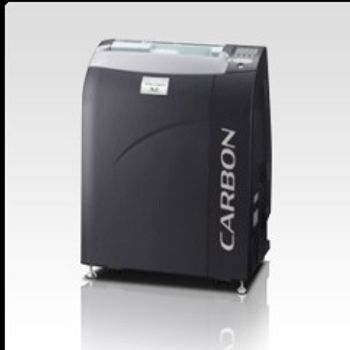Fujifilm - Carbon XL
by Fujifilm


Fuji created the FCR Carbon digital x-ray series based on feedback from thousands of users. What did they say? Reduce the system’s footprint. Make image previews quicker. Create a means to support multiple imaging applications. And deliver uncompromised image quality, consistently. That’s why with FCR Carbon, you get all the productivity and image quality benefits of a traditional FCR system in a size that’s perfect for every imaging environment — and with the throughput capacity that meets your needs. FCR Carbon systems have a compact footprint of less than 2.5 square feet and are only 32” tall, so they can fit in any exam room, under counters – virtually anyplace where space is at a premium. And with their high throughput and image availability beginning in 10-12 seconds, Carbon XL systems are fast enough to handle busy periods as well as the most demanding environments, where quick image access is critical. Plus, they can be networked to other FCR systems, so they’re flexible enough to support remote locations like ICU or surgery where the Carbon X is ideally suited. Each FCR Carbon system includes Fuji’s Flash IIP console, the first technologist workstation to offer a fully customizable user interface. Flex UI™ software allows users to access functions used most frequently in the QC process, without adding workflow steps. Add annotation markers to images with a single tap on the screen. With another tap, flip or rotate an image. Or type free-text comments to a radiologist. Since there’s a wide range of anatomical menus to choose from, images are processed appropriately for an optimal first-up display. The result: technologists don’t waste valuable time trying to improve the quality of an image for the intended exam. And with the Flash IIP console, your hospital procedure codes can be directly mapped to Fuji’s exam menus, minimizing workflow steps, errors and time-consuming corrections.
2Replies4 years ago | 356 intermittent communication issue I am getting an intermittent communication error between iip and CR unit. I have replaced the switch and cat5 cables several times. I have replaced the iip twice. I have taken the unit off the network and am running only the iip and reader. It worked while I was there , doctor comes back 2 days later turns unit on same communication error. Error logs only give me generic message of 11530. Do you think it may be the CR units lan card or main cpu board. This issue does not happen ever time the unit is booted up. Any help would be greatly appreciated.Reply |
2Replies6 years ago | sync software Does anybody know how to synchronize the software for FCR Carbon with the workstation?Reply |
0Replies7 years ago | How often should I do a PM Does anyone have the manual for either the Carbon XL, or CR IR 356? I'm trying to find out how often the manufacturer suggests I do a PM , if at all. Any info would be greatly appreciated.Reply |
[list] [*] Multi-objective Frequency Processing (MFP) selectively and simultaneously applies varying degrees of contrast and spatial frequency enhancement to different-sized structures within the same image. This improves the visibility of both dense and peripheral tissue. [*] Dynamic Range Control (DRC) improves visibility of both dense and peripheral tissue. [*] Flexible Noise Control (FNC) extracts noise data and suppresses noise levels from images without losing sharpness and associated diagnostic information. This improves granularity in noisy anatomical regions and improves image quality in exams when lower doses are expected. [*] Grid Pattern Removal (GPR) automatically detects grid patterns, then uses a two-dimensional technique to remove them. This prevents the appearance of a moiré pattern, which can occur when using a stationary grid. [*] Exposure Data Recognizer (EDR) automatically detects the most important data captured by an Imaging Plate (IP), then applies anatomically-specific processing to present the optimal image for the intended exam. By masking noise and other useless information, EDR optimizes images for diagnosis. [*] Every image is scanned at HQ (10 pixel/mm) spatial resolution, regardless of plate size. This means that you get exceptional detail every time without ever having to use special imaging plates – and without impacting throughput. [*] Fuji’s IPs feature the highest DQE and signal-to-noise ratio of available cassette-based systems on the market today. [/list]